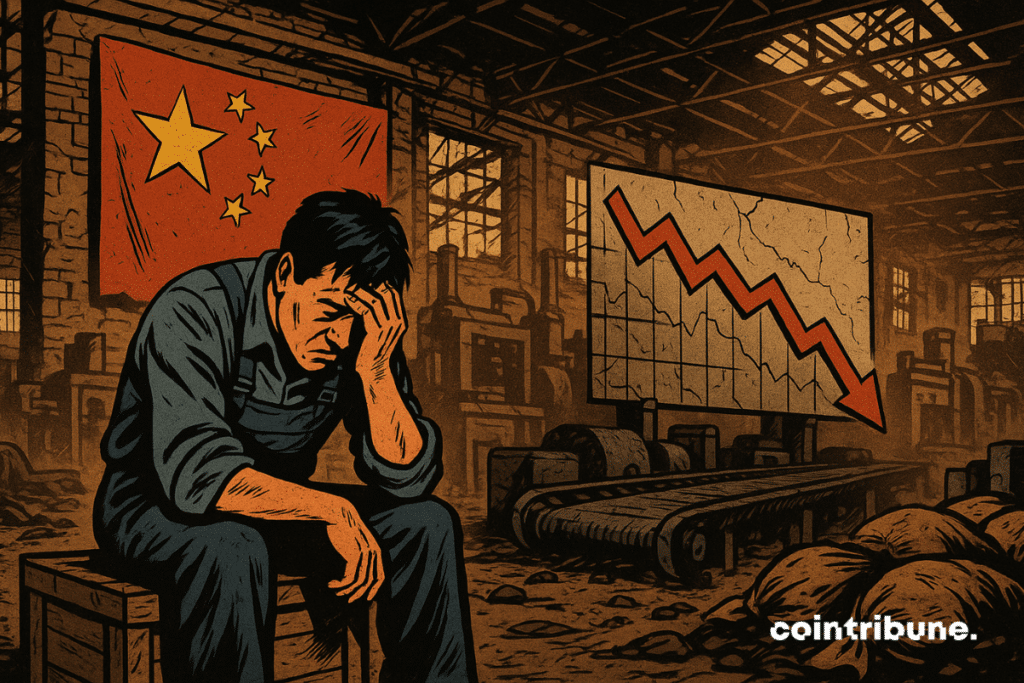Chinese Industry Contraction Raises Global Fears
The Chinese industry is showing signs of weakness. For the first time in over a year, the country’s manufacturing activity contracted, according to the latest figures from the National Bureau of Statistics. Indeed, the new American tariff offensive relaunched by Donald Trump, with duties of up to 145 %, is beginning to produce its effects. On Wall Street as well as in Beijing, concerns are rising. This trade showdown between the two powers is awakening fears of a global slowdown with systemic consequences.

In Brief
- The trade war relaunched by Donald Trump is already weakening the Chinese economy, with massive tariff measures at 145 %.
- China’s manufacturing PMI index fell to 49 in April 2025, signaling a contraction in industrial activity for the first time in over a year.
- Other indicators, such as the services PMI and growth forecasts, confirm a widespread economic slowdown.
- China is adopting a hardline stance against the United States, increasing its economic isolation instead of seeking appeasement.
Chinese Industry Under Pressure
The first figures dropped like a warning on the markets. Indeed, the manufacturing PMI index of China settled at 49 in April, down from 50.5 in March. A threshold below 50 signals a contraction of industrial activity.
According to the National Bureau of Statistics, this drop is attributed to a high comparison base and “sudden changes in the external environment.” This is the sharpest contraction recorded since December 2023, a turning point that coincides with the aggressive return of American protectionist measures.
Washington has indeed imposed prohibitive tariffs of 145 % on the majority of Chinese products. Although some sectors like electronics and imports of steel and aluminum for automobiles were exempted, the political message is clear: the resurgence of a hard economic nationalism, with China as the direct target.
This manufacturing retreat fits into an overall tense economic climate. The data reveal a slowdown more significant than the industrial sector alone. Notable elements include :
- The non-manufacturing PMI, which measures the services sector, declined to 50.4 in April, down from 50.8 in March, signaling an almost slowdown in that area as well ;
- Société Générale anticipates a 70 % drop in Chinese exports to the United States, representing a direct negative shock of 2 % on GDP ;
- Oxford Economics estimates that “the impact of tariffs means that China’s growth target is no longer achievable” ;
- UBS and Goldman Sachs have lowered their growth forecasts for China in 2025 to around 4 %, while Beijing officially targets 5 %.
These figures paint the picture of a deep slowdown, amplified by sustained trade tensions, and raise fears of a loss of competitiveness for the Chinese economy.
A Timid Response from Beijing, Between Political Resistance and Targeted Measures
While the indicators plunge into the red, Beijing’s reaction remains measured, almost cautious. The Chinese government announced this week targeted measures to support struggling export companies, including easier access to credit and incentives for domestic consumption.
However, no massive stimulus initiative has been unveiled. Ting Lu, chief economist for China at Nomura, stated :
We believe that Beijing needs to take bolder measures.
In a recent note, he calls to address structural challenges such as “the collapse of the real estate market, pension system reform, and improving international relations.” For now, the central authority seems to want to buy time and favors resilience over direct intervention.
On the diplomatic front, Beijing adopts an aggressive posture. Foreign Minister Wang Yi warned international partners against any complacency in the face of Washington’s tariff pressures. “Giving in to customs blackmail would only embolden the tyrant,” he said.
This discourse highlights a refusal to bow to American demands, but also a form of growing isolation. By refusing to open the way to trade negotiations, China could worsen an economic isolation already noticeable in the markets.
This stance of firmness has significant implications both in the short and medium term. If Beijing continues to exclude massive stimulus and refuses to soften its diplomatic positions, the risk is a prolonged slowdown and a loss of investor confidence. In such a climate, capital flows could divert from traditional Chinese assets. Some analysts already believe that this instability could indirectly strengthen the appeal of cryptos, considered by part of the market as an alternative to growing monetary and geopolitical tensions.
Maximize your Cointribune experience with our "Read to Earn" program! For every article you read, earn points and access exclusive rewards. Sign up now and start earning benefits.
Diplômé de Sciences Po Toulouse et titulaire d'une certification consultant blockchain délivrée par Alyra, j'ai rejoint l'aventure Cointribune en 2019. Convaincu du potentiel de la blockchain pour transformer de nombreux secteurs de l'économie, j'ai pris l'engagement de sensibiliser et d'informer le grand public sur cet écosystème en constante évolution. Mon objectif est de permettre à chacun de mieux comprendre la blockchain et de saisir les opportunités qu'elle offre. Je m'efforce chaque jour de fournir une analyse objective de l'actualité, de décrypter les tendances du marché, de relayer les dernières innovations technologiques et de mettre en perspective les enjeux économiques et sociétaux de cette révolution en marche.
The views, thoughts, and opinions expressed in this article belong solely to the author, and should not be taken as investment advice. Do your own research before taking any investment decisions.